YAMAHA SLIDER 50 2003 Owner's Guide
Manufacturer: YAMAHA, Model Year: 2003, Model line: SLIDER 50, Model: YAMAHA SLIDER 50 2003Pages: 80, PDF Size: 2.76 MB
Page 31 of 80

EAU00372
OPERATION AND IMPORTANT RIDING POINTS
Starting the engine .............................................................................. 5-1
Starting a warm engine ....................................................................... 5-2
Starting off ........................................................................................... 5-2
Acceleration and deceleration ............................................................. 5-3
Braking ................................................................................................ 5-3
Tips for reducing fuel consumption ..................................................... 5-3
Engine break-in ................................................................................... 5-4
Parking ................................................................................................ 5-5
5
Page 32 of 80
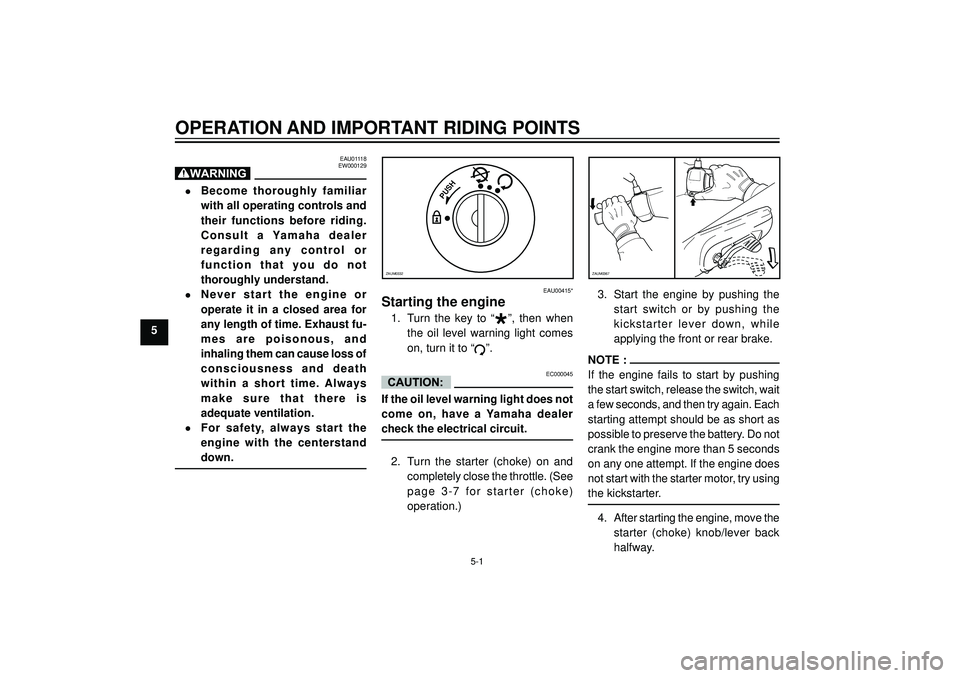
OPERATION AND IMPORTANT RIDING POINTS
5
EAU01118
EW000129
•Become thoroughly familiar
with all operating controls and
their functions before riding.
Consult a Yamaha dealer
regarding any control or
function that you do not
thoroughly understand.
•Never start the engine or
operate it in a closed area for
any length of time. Exhaust fu-
mes are poisonous, and
inhaling them can cause loss of
consciousness and death
within a short time. Always
make sure that there is
adequate ventilation.
•For safety, always start the
engine with the centerstand
down.
P
U
S
H
ZAUM0332ZAUM0367
EAU00415*
Starting the engine
1. Turn the key to “
*
”, then when
the oil level warning light comes
on, turn it to “
”.
EC000045
If the oil level warning light does not
come on, have a Yamaha dealer
check the electrical circuit.
2. Turn the starter (choke) on and
completely close the throttle. (See
page 3-7 for starter (choke)
operation.)3. Start the engine by pushing the
start switch or by pushing the
kickstarter lever down, while
applying the front or rear brake.
NOTE :
If the engine fails to start by pushing
the start switch, release the switch, wait
a few seconds, and then try again. Each
starting attempt should be as short as
possible to preserve the battery. Do not
crank the engine more than 5 seconds
on any one attempt. If the engine does
not start with the starter motor, try using
the kickstarter.
4. After starting the engine, move the
starter (choke) knob/lever back
halfway.
5-1
Page 33 of 80

OPERATION AND IMPORTANT RIDING POINTS
5
ZAUM0150
EAU00433
Starting off
NOTE :
Before starting off, allow the engine to
warm up.
1. While pulling the rear brake lever
with your left hand and holding the
grab bar with your right hand,
push the scooter off the
centerstand.
2. Sit astride the seat, and then
adjust the rear view mirrors.
3. Switch the turn signal on.
4. Check for oncoming traffic, and
then slowly turn the throttle grip
(on the right) in order to take off.
5. Switch the turn signal off.
EAU01258
Starting a warm engine
Follow the same procedure as for
starting a cold engine with the excep-
tion that the starter (choke) is not
required when the engine is warm.
ECA00045
For maximum engine life, never
accelerate hard when the engine is
cold!
5. When the engine is warm, turn the
starter (choke) off.
NOTE :
The engine is warm when it responds
normally to the throttle with the starter
(choke) turned off.
5-2
EC000046
See page 5-4 for engine break-in ins-
tructions prior to operating the
vehicle for the first time.
Page 34 of 80

OPERATION AND IMPORTANT RIDING POINTS
5
EAU00434
Acceleration and
deceleration
The speed can be adjusted by opening
and closing the throttle. To increase the
speed, turn the throttle grip in direction
a . To reduce the speed, turn the
throttle grip in direction b .
a b
ZAUM0199ZAUM0269
EAU00435
Braking
1. Close the throttle completely.
2. Apply both front and rear brakes
simultaneously while gradually
increasing the pressure.
EW000057
•Avoid braking hard or suddenly
(especially when leaning over
to one side), otherwise the
scooter may skid or overturn.
•Railroad crossings, streetcar
rails, iron plates on road cons-
truction sites, and manhole
covers become extremely
slippery when wet. Therefore,
slow down when approaching
such areas and cross them with
caution.
•Keep in mind that braking on a
wet road is much more difficult.
•Ride slowly down a hill, as
braking downhill can be very
difficult.
5-3
Page 35 of 80
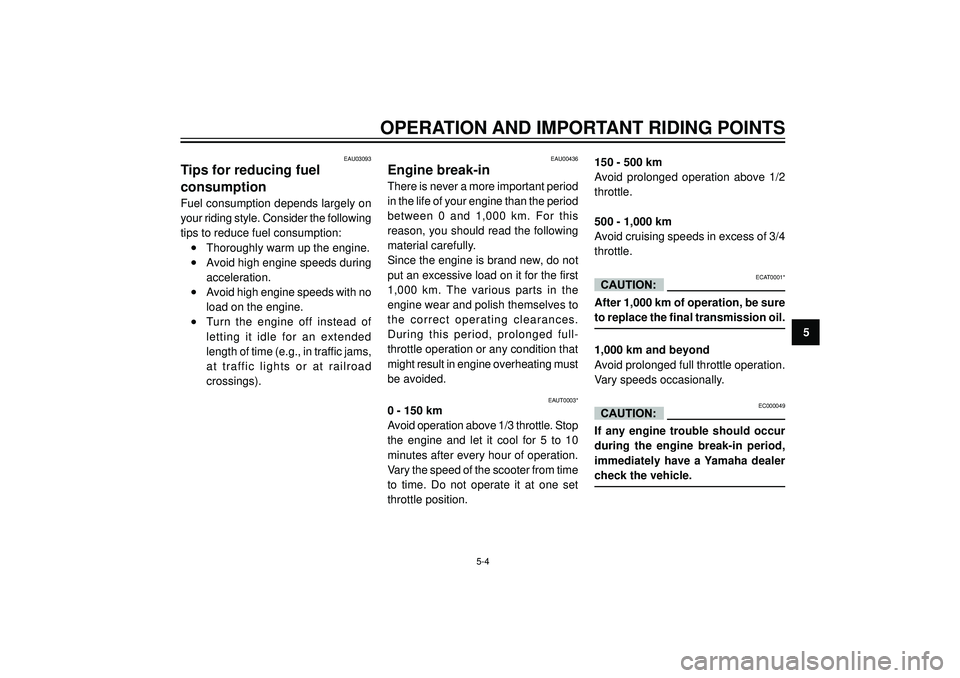
OPERATION AND IMPORTANT RIDING POINTS
5
EAU03093
Tips for reducing fuel
consumption
Fuel consumption depends largely on
your riding style. Consider the following
tips to reduce fuel consumption:
•Thoroughly warm up the engine.
•Avoid high engine speeds during
acceleration.
•Avoid high engine speeds with no
load on the engine.
•Turn the engine off instead of
letting it idle for an extended
length of time (e.g., in traffic jams,
at traffic lights or at railroad
crossings).
EAU00436
Engine break-in
There is never a more important period
in the life of your engine than the period
between 0 and 1,000 km. For this
reason, you should read the following
material carefully.
Since the engine is brand new, do not
put an excessive load on it for the first
1,000 km. The various parts in the
engine wear and polish themselves to
the correct operating clearances.
During this period, prolonged full-
throttle operation or any condition that
might result in engine overheating must
be avoided.
EAUT0003*
0 - 150 km
Avoid operation above 1/3 throttle. Stop
the engine and let it cool for 5 to 10
minutes after every hour of operation.
Vary the speed of the scooter from time
to time. Do not operate it at one set
throttle position.150 - 500 km
Avoid prolonged operation above 1/2
throttle.
500 - 1,000 km
Avoid cruising speeds in excess of 3/4
throttle.
ECAT0001*
After 1,000 km of operation, be sure
to replace the final transmission oil.
1,000 km and beyond
Avoid prolonged full throttle operation.
Vary speeds occasionally.
EC000049
If any engine trouble should occur
during the engine break-in period,
immediately have a Yamaha dealer
check the vehicle.
5-4
Page 36 of 80

OPERATION AND IMPORTANT RIDING POINTS
5
EAU00461
Parking
When parking, stop the engine, and
then remove the key from the main
switch.
EW000058
•Since the engine and exhaust
system can become very hot,
park in a place where
pedestrians or children are not
likely to touch them.
•Do not park on a slope or on
soft ground, otherwise the
scooter may overturn.
EC000062
Never park in an area where there
are fire hazards such as grass or
other flammable materials.
5-5
Page 37 of 80
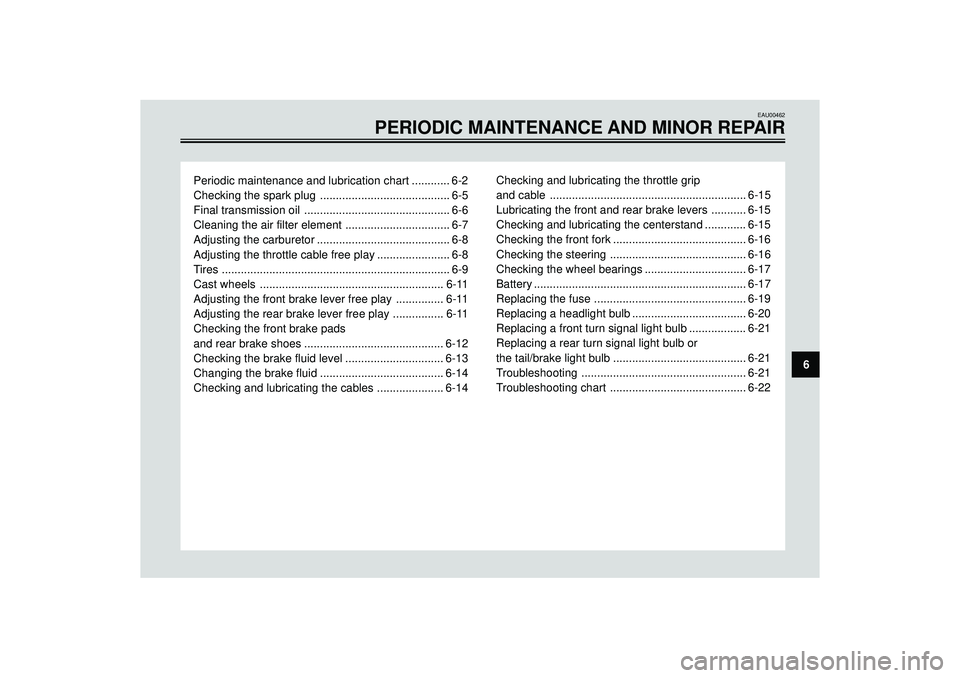
EAU00462
PERIODIC MAINTENANCE AND MINOR REPAIR
Periodic maintenance and lubrication chart ............ 6-2
Checking the spark plug ......................................... 6-5
Final transmission oil .............................................. 6-6
Cleaning the air filter element ................................. 6-7
Adjusting the carburetor .......................................... 6-8
Adjusting the throttle cable free play ....................... 6-8
Tires ........................................................................ 6-9
Cast wheels .......................................................... 6-11
Adjusting the front brake lever free play ............... 6-11
Adjusting the rear brake lever free play ................ 6-11
Checking the front brake pads
and rear brake shoes ............................................ 6-12
Checking the brake fluid level ............................... 6-13
Changing the brake fluid ....................................... 6-14
Checking and lubricating the cables ..................... 6-14
6 Checking and lubricating the throttle grip
and cable .............................................................. 6-15
Lubricating the front and rear brake levers ........... 6-15
Checking and lubricating the centerstand ............. 6-15
Checking the front fork .......................................... 6-16
Checking the steering ........................................... 6-16
Checking the wheel bearings ................................ 6-17
Battery ................................................................... 6-17
Replacing the fuse ................................................ 6-19
Replacing a headlight bulb .................................... 6-20
Replacing a front turn signal light bulb .................. 6-21
Replacing a rear turn signal light bulb or
the tail/brake light bulb .......................................... 6-21
Troubleshooting .................................................... 6-21
Troubleshooting chart ........................................... 6-22
Page 38 of 80

PERIODIC MAINTENANCE AND MINOR REPAIR
6
EAU00466*
EW000061
This scooter is designed for use on
paved roads only. If this scooter is
operated in abnormally dusty,
muddy or wet conditions, the air
filter element should be cleaned or
replaced more frequently, otherwise
rapid engine wear may result.
Consult a Yamaha dealer for proper
maintenance intervals.
EAU03453
Safety is an obligation of the owner.
Periodic inspection, adjustment and
lubrication will keep your vehicle in the
safest and most efficient condition pos-
sible. The most important points of
scooter inspection, adjustment, and
lubrication are explained on the
following pages.
EW000060
If you are not familiar with scooter
maintenance work, have a Yamaha
dealer do it for you.
EW000063
Modifications not approved by
Yamaha may cause loss of perfor-
mance and render the vehicle unsafe
for use. Consult a Yamaha dealer
before attempting any changes.
6-1
Page 39 of 80
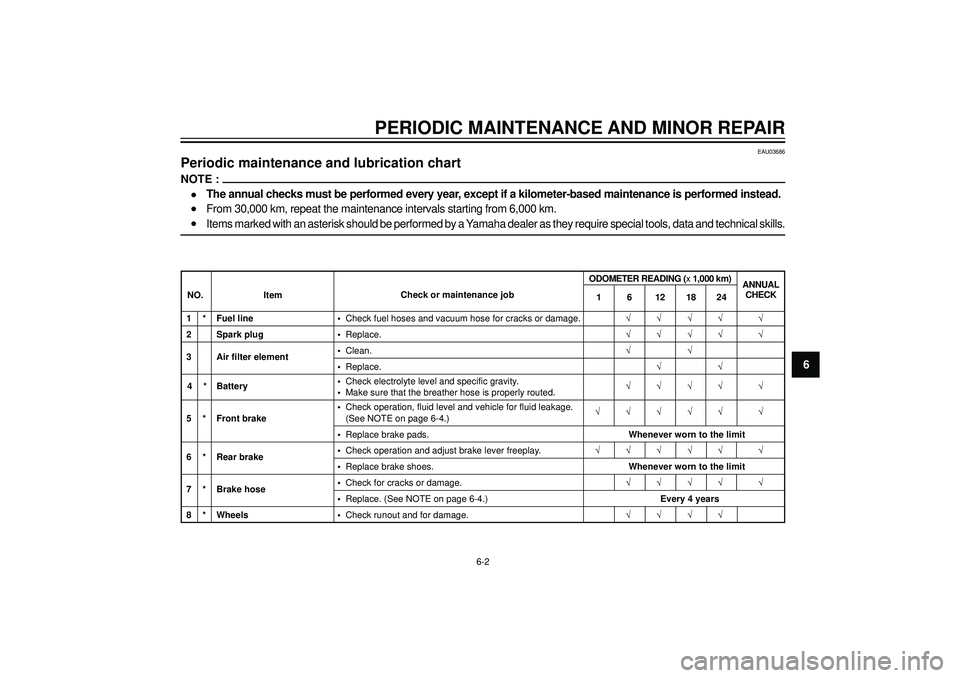
PERIODIC MAINTENANCE AND MINOR REPAIR
6
EAU03686
Periodic maintenance and lubrication chart
NOTE :
•The annual checks must be performed every year, except if a kilometer-based maintenance is performed instead.
•From 30,000 km, repeat the maintenance intervals starting from 6,000 km.
•Items marked with an asterisk should be performed by a Yamaha dealer as they require special tools, data and technical skills.
1 * Fuel line •Check fuel hoses and vacuum hose for cracks or damage.√√√√ √
2 Spark plug •Replace.√√√√ √
3 Air filter element•Clean.√√•Replace.√√
4 * Battery•Check electrolyte level and specific gravity.
√√√√ √
•Make sure that the breather hose is properly routed.
•Check operation, fluid level and vehicle for fluid leakage.
√√√√√ √
5 * Front brake(See NOTE on page 6-4.)
•Replace brake pads.Whenever worn to the limit
6 * Rear brake•Check operation and adjust brake lever freeplay.√√√√√ √•Replace brake shoes.Whenever worn to the limit
7 * Brake hose•Check for cracks or damage.√√√√ √•Replace. (See NOTE on page 6-4.)Every 4 years
8 * Wheels •Check runout and for damage.√√√√
ODOMETER READING (x 1,000 km)
NO. ItemCheck or maintenance job
1
ANNUAL
CHECK
6121824
6-2
Page 40 of 80
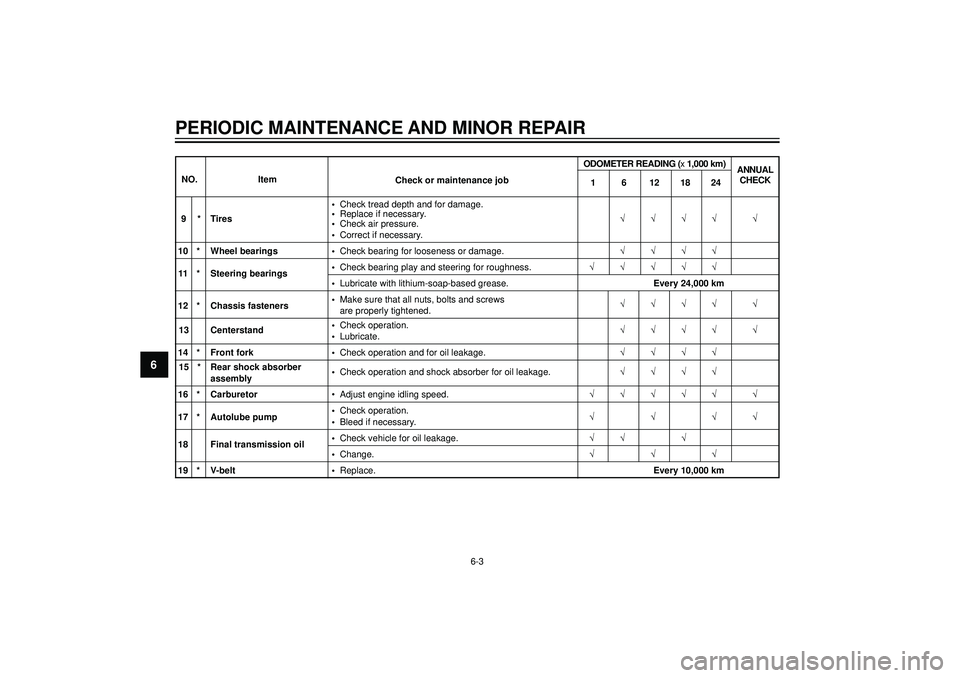
PERIODIC MAINTENANCE AND MINOR REPAIR
6
6-3 •Check tread depth and for damage.
9 * Tires•Replace if necessary.
•Check air pressure.√√√√ √
•Correct if necessary.
10 * Wheel bearings •Check bearing for looseness or damage.√√√√
11 * Steering bearings•Check bearing play and steering for roughness.√√√√√•Lubricate with lithium-soap-based grease.Every 24,000 km
12 * Chassis fasteners•Make sure that all nuts, bolts and screws
√√√√ √
are properly tightened.
13 Centerstand•Check operation.
√√√√ √
•Lubricate.
14 * Front fork •Check operation and for oil leakage.√√√√
15 * Rear shock absorber
•Check operation and shock absorber for oil leakage.√√√√
assembly
16 * Carburetor• Adjust engine idling speed.√√√√√ √
17 * Autolube pump•Check operation.
√√√√
•Bleed if necessary.
18 Final transmission oil•Check vehicle for oil leakage.√√ √•Change.√√√
19 * V-belt •Replace.Every 10,000 km
NO. Item
Check or maintenance job
ODOMETER READING (x 1,000 km)
1ANNUAL
CHECK6121824